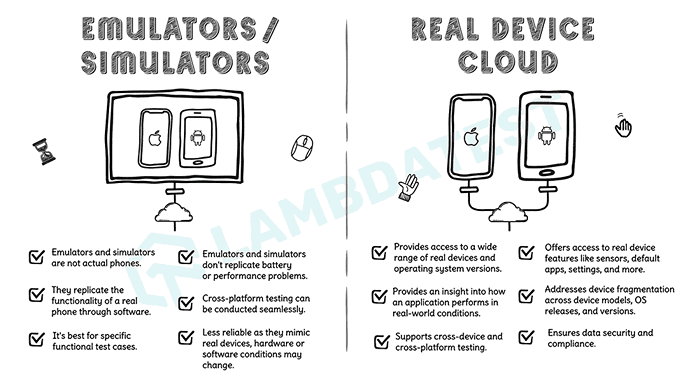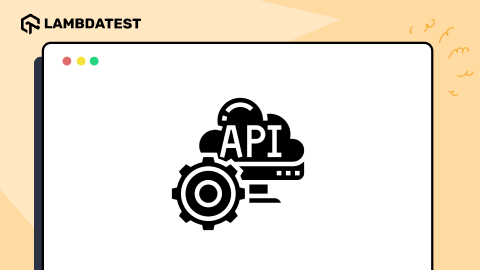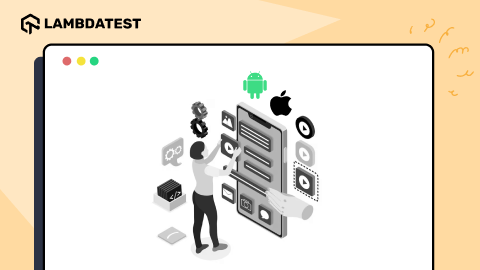Emulator vs Simulator vs Real Device Testing: Key Differences
Praveena Manohar
Posted On: March 16, 2022
![]() 178546 Views
178546 Views
![]() 20 Min Read
20 Min Read
In a gist an emulator replicates the behavior of a specific piece of hardware or software in another system and behaves like a qriginal system, while simulator mimics the behavior of a system, but it doesn’t replicate it exactly so simulator only approximates it. Mobile app testing involves running a series of tests to ensure that the functionality, performance, usability, and stability of the app meet the various testing requirements. It is no wonder that the mobile app testing sector is thriving across the globe, with over 7.7 billion by 2028 . Therefore, the use of mobile apps worldwide is increasing along with the number of app downloads.

The revenue generated from mobile apps is expected to reach $935 billion in 2024. With this increased app usage, companies must adopt quality and mobile device testing solutions that let them develop their mobile applications in a cost-effective and timely manner. The critical part of having a robust testing process is to choose the device on which the test is being run. Selecting the right testing solution with a wide range of devices, operating systems, hardware, and browsers is critical.
Mobile device testing solution is all about choosing between emulator vs simulator vs real devices. Real devices are a great combination of value and benefits, but they also come with a specific cost. On the other hand, emulators and simulators for mobile devices can also be beneficial and give unique benefits to developers and testers, but they also have drawbacks.
This article explores the difference between emulator vs simulator vs real device and when to choose the right solution for your business.
TABLE OF CONTENTS
Types of Mobile device testing solutions
Mobile app testing is an integral part of the software development lifecycle. It ensures that you release only high-performing apps and protect its brand value. Testing has also developed with several advancements and emerging mobile testing solutions with the technology evolving.
The main types of devices to conduct mobile app testing are:
- Virtual Devices
- Real Devices
To learn more about mobile app testing it is important to learn its basics follow this guide on mobile app testing basics and get detail insights.
What is Virtual Device Testing?
A Virtual Testing Device is not an actual phone but a software program that gives similar functionality as the real phone. It mimics the functionalities of a smartphone that helps the testers to run their application and know how it would run on a real device.
There are two types of virtual devices – Emulators and Simulators
What are Emulators?
An emulator is a software program that mimics the features of another software, hardware, or OS of the target device. It lets you test your app by emulating a real device. Emulators are used in automation, unit testing, and debugging. Software is typically platform-specific, so developers make separate applications for Android, iOS, Windows, and Mac.
Different types of emulators use various emulation techniques. Regardless, the final aim is always the same: to simulate the experience of using the original hardware or application. Some emulators outperform the authentic product in terms of performance and incorporate extra features. Several online APK emulators are available to run app tests on various devices and OS versions without needing to configure and install them on the machine.
What are Simulators?
A simulator is also a software program that allows your device to run specific programs built for different operating systems. Simulators are written in high-level languages and are primarily used for iOS devices. iOS Simulators for app testing are often used to ensure that the application works correctly across different environments as intended.
For example, to evaluate an app’s capacity to transfer data to another app. Because the underlying hardware configuration is unlikely to influence data transfers for your program significantly, a simulated environment will usually be sufficient. Simulated testing environments are also helpful in ensuring that an application’s interface shows correctly at multiple screen resolutions.
Perform real device testing on Emulators and Simulators over a wide range of devices options and OSTry LambdaTest now!
To learn more about the how to perform emulators and simulators follow this guide on mobile app testing using Emulators and Simulators
Emulator vs Simulator Differences
Emulators are virtual tools that replicate both hardware and software features of a real device, typically optimized for Android app development. On the other hand, simulators provide an environment that imitates the behaviors, variables, and configurations found in an iOS app’s production setting. Though emulators and simulators are virtual testing devices serving similar purposes, they differ from each other in several ways, as shown below:
| Emulators | Simulators |
| It duplicates all the software, hardware, and operating systems of an actual device. | It creates an environment that mimics the behavior and configuration of a real device |
| The emulator is usually a complete re-implementation of the original software. | The simulator is a partial re-implementation of the existing software. |
| Manufacturers or OEMs typically provide emulators for their platforms. | Manufacturers or other organizations provide simulators. |
| Programs are written in Machine-level assembly language. | Programs are written in High-level language. |
| Emulators are more reliable and suitable for debugging. | Simulators can be difficult for debugging purposes. |
| Binary translation makes them slow. | Simulators work faster as there is no binary translation. |
| Example of the emulator: Android SDK. | Example of simulator: iOS simulator. |
To understand the difference in more detailed form follow this guide on Emulator vs. Simulator for mobile testing and get valuable insights.
Pros and Cons of Testing on Emulators and Simulators
Emulators and simulators are virtual devices that mimic real devices and offer several advantages. However, mobile application testing on virtual devices has its ups and downs.
Advantages
- Cost – The most obvious advantage is that virtual device testing is cheaper and applies to local and cloud-based solutions.
- Capturing Results – Working on a virtual device lets the user capture results easily by taking a screenshot of the bug observations.
- Variety – Virtual device testing allows you to test your application across various platforms and use cases that require multiple devices and operating systems.
- Availability– Simulators and Emulators are readily available for use without any constraints.
Disadvantages
- Virtual devices are accessible only for specific platforms. They sometimes can be incompatible with your application. For example, emulators can test only Android devices, not supporting different operating systems.
- Virtual device testing cannot replicate hardware configurations.
- Performance validation is unreliable since these observations may vary with the OS enhancements. Even if the testing goes perfectly, you cannot be sure that your result can be accurate on a real device.
Also, read – Why Android Application Testing Is Important?
Is App Automation feasible on Emulators and Simulators?
Automating mobile apps on emulators and simulators cannot address all of the issues that may arise during a real-world scenario; thus, real device testing is essential. Customers will seek other solutions owing to common difficulties such as low battery life, app incompatibility, or an inconveniently placed search bar.
Below are the challenges of emulators and simulators for running app test automation –
- May impact the tester’s confidence on the arrival of the new version of OS.
- The Beta version may remain unavailable for testing beta apps, causing specific testing restrictions.
- The screenshot of the issues identified while building the app may render differently if the new version of the OS is released.
- Internal storage and related issues can easily hinder mobile app performance.
- Mobile automation testing with emulators and simulators does not always yield excellent results as performance validations fluctuate with OS upgrades.
- Battery issues, network connectivity, GPS sensors, and gestures cannot be replicated.
- Impossible to test app behavior while receiving calls or texts or simulate touch screen issues.
Read – Key Challenges & Solutions Of Mobile App Testing
Therefore, a practical approach is to use a Real Device cloud for app test automation. Automated app testing on real devices can help you test apps in real-world conditions. You can also follow the mobile testing pyramid – an approach for agile teams to carry out mobile automation tests in an efficient and organized manner. Since the devices and number of platforms are rising, this mobile testing pyramid gives you the structured approach to perform mobile app testing quickly and easily.
Real Device cloud for native app testing can help eliminate costs of setting up an in-house device lab, native real-device experience, easy debugging, monitoring apps in real-user condition, and much more.
What is Real Device Testing?
Real devices are various mobile handset models that the end-user would use. Real device testing is a process of testing your web, hybrid, and native applications on physical devices. This means that you’re testing the exact way that your users are operating their mobile devices. This allows you to run and test the functionality of your application and ensure that it works smoothly in customer handsets.
Real devices will have different factors such as temperature and other software that must be considered during testing to ensure better app performance. A smartphone can include a lot of interruptions like phone calls, battery issues, screen lock, and so on. You must test these interruptions, and you can do this only by testing directly on real devices.
The results generated from real device testing are highly accurate. However, the cost is higher since the company should buy multiple real devices, which have to be updated from time to time with new and frequent device releases in the market.
Pros and Cons of Real Device Testing
Shown below are the advantages and disadvantages of real device testing –
Advantages
- Accuracy – Real device testing provides more accurate and reliable measurements. The testing is typically performed in a live environment. This is important since network-related actions might affect the quality of your app. For example, what happens when a user gets a call or text in the middle of a transaction? How is the performance of your app impacted in such a scenario? These types of defects cannot be detected using emulators.
- Better user experience – Testing on real devices will help you understand the user experience by taking memory, size, CPU, and so on into consideration.
- Expose performance issues – It is easier to expose performance defects with real devices.
Disadvantages
- High Costs – As mentioned earlier, real device testing is more expensive. The cost involved in procuring the devices and managing the physical sources can be complicated.
- Slow debugging – Testing on real devices can slow down the debugging process during the initial software development stages.
- Device fragmentation – Multiple devices types getting released in the market, different operating systems, and frequent software upgrades make testing on real devices more difficult.
Also, read – How To Deal With iOS Version Fragmentation?
You can refer to the below video tutorial on how to perform real-time testing on real devices.
Emulator vs Simulator vs Real Devices Differences
Mobile applications are used on actual smartphones and not on emulators. You will achieve better quality when testing is done on real devices. However, considering cost and convenience, testing real devices for every application you develop is not feasible.

In this section, we will understand the difference between simulators and emulators vs. real devices. Check the table below to understand the differences between the capabilities of these devices.
| Emulators and Simulators | Real devices |
|---|---|
| The emulators and simulators are not an actual phone. It is the software that gives the same functionality as a real phone. | Real device testing is testing performed on physical devices. |
| The emulators and simulators cannot simulate the battery and other performance issues. | Real device testing can perform these tests seamlessly. |
| It is primarily suitable for certain types of functional test case executions | It is more suitable to perform real-time performance testing. |
| Minimal cost is involved. | Real device testing is costly since you have to buy multiple devices to test your application. |
| Emulators and Simulators testing, in most cases, is open source and free. | It is not free or open-source. You need to buy actual devices to see how your app works on that device. |
| Real performance issues such as network or battery issues cannot be performed with emulators/simulators. | It allows real-time performance testing issues such as network, battery, location, notifications, etc. |
| Cross-platform testing can be conducted seamlessly. | Cross-platform testing is not supported. |
| Less reliable – emulators and simulators only mimic the real device, and hardware or software conditions might change regularly. | It gives accurate results and is more reliable. |
When to test on Emulator, Simulator, and Real devices?
Generally, developers would like to follow different mobile app testing strategies for every app that is being developed. Due to this approach, it is crucial to understand the type of app you want to develop and the device that needs to be adopted to test your application. When used appropriately, each testing device can offer various features. They can deliver optimized results that could make app testing a lot easier.
It is always advisable for developers testers to have a checklist when perform testing using Emulator, Simulator or on a real device follow this guide on the ultimate mobile app testing checklist and make the testing must easier.
The best practice includes testing on the correct device to achieve the desired outcomes.
- Virtual devices offer a better debugging option, and they are best during the initial stages of development. With frequent iterations in the initial development stages, using a virtual device for testing could make the development cycle faster and more efficient.
- Virtual testing can get you a fresh instance, and you don’t have to worry about changing the settings. Developers in most agile companies use virtual device testing to do basic sanity. Also, the speed and frequency of testing impact the user’s decision to test on emulators/simulators. However, virtual devices might fail to find the memory leak, high memory usage, latency, and network delays. They also do not include custom operating systems.
- On the other hand, considering the accuracy factor and sanity, testing on real devices is more effective if you genuinely want to understand the user experience.
- Furthermore, it is much easier to identify performance defects with real devices. These types of defects cannot be identified accurately using emulators or simulators. However, real device testing is on the expensive side. The logistics and costs involved in purchasing and managing real devices are not easy.
- The ultimate aim of your business is to ensure that more customers are using your application. Thus, building a user-friendly, high-performing mobile application is essential. Choose the right tool depending on your company’s risk management approach, business needs, and customer demands.
There are many tools available for you to perform mobile app testing but it is important to choose the right tool that gives you all the benefits that you are looking for and best suites your project needs, follow this guide on mobile testing tools and get hands on various tools that can help you take informed decision.
Choosing the Optimal Testing Strategy
Both simulators and emulators vs. real devices have pros and cons. To minimize the effects of their disadvantages and to make the most out of the advantages, it is vital to understand and adopt the best mobile app testing strategy. Using a mobile app testing cloud is ideal for overcoming the above-stated scenarios. Cloud-based mobile application testing allows you to connect to many mobile devices and test the functionalities regardless of their location. Cloud mobile app testing is also an excellent solution to test applications manually or automate app testing on a large scale.
Cloud-based app testing platform offers different options that combine various OS versions, mobile app testing frameworks, etc. They also support parallel testing, record the testing results, and more. Cloud testing is ideal for agile development, and you may use a private cloud for testing, so security isn’t an issue.
Although it’s best to rely on real devices or use emulators at the initial stages of the SDLC, you need to address and scale up your testing strategy by choosing a Real Device cloud provider and running your tests on many devices as required.
When you are familiar with the checklist, it becomes easier for developers and testers to identify and prioritize the most critical scenarios for execution based on the project’s importance. To learn how to determine the key scenarios to be executed, follow this guide on the most important mobile app testing scenarios and gain valuable insights.
Emulator vs Simulator vs Real Device Testing
In this section on emulator vs. simulator vs. real devices, we explore how to leverage the immense capabilities of cloud test execution platforms like LambdaTest for mobile app testing. LambdaTest is an AI-powered test orchestration and execution platform that lets you run manual and automated tests at scale with over 3000 real devices, browsers, and OS combinations.
This platform supports mobile application testing on an online device farm with a wide range of real devices, OS, emulators, and simulators. You can test and debug your application much faster using either the real device cloud or emulators and simulators.
Moreover, you don’t have to set up an on-premise device lab. Using LambdaTest, you can instantly test on a Real Device cloud with no setup and maintenance costs and it easily allows you to capture device logs.
For app automation, you can harness the power of the LambdaTest Appium testing platform and test mobile apps on the Appium mobile device cloud. It offers several features to test like native app features, gestures and interactions, viewing comprehensive test logs, geolocation testing, LambdaTest tunnel to test locally hosted apps, 120+ LambdaTest integrations with third-party tools, and much more.
Learn how to run real-time app testing on the LambdaTest platform in the following video tutorial.
Follow the LambdaTest YouTube Channel for more such videos around automation testing, Cypress, Expresso, XCUIT , and more.
Conclusion
Mobile app testing has become an integral part of the app development lifecycle. To make sure your software works seamlessly on different devices, you must test it thoroughly before shipping it to the market, thereby minimizing the risks associated with launching a faulty application.
Thus, adopting a Real device cloud for testing is more convenient, cheaper, and provides real-time analytics on the performance of your application. You can configure your automation frameworks tests on the LambdaTest cloud grid using the LambdaTest Capabilities Generator. This approach helps the testers to find the bugs and the developers to fix the identified bugs while keeping the maintenance and costs low.
Hope by now you have understood the Android emulator online vs real device and iOS simulator vs real device differences. If you have questions and suggestions, please feel free to shoot them in the comment section below.
Frequently Asked Questions (FAQs)
Which is better emulator or real device?
Testing on real devices is better than emulator testing. Real device testing allows you to check the app’s functionality, usability, and accuracy in real-world environments. You can test the native features like battery issues, GPS sensors, network connectivity, gestures, etc.
What are the disadvantages of emulator?
Shown below are the cons of using an emulator for testing purposes –
- Lack of accuracy.
- It cannot test the device native features like gestures, GPS sensors, network connectivity, etc.
- Emulators can’t replicate the app’s behavior while receiving phone calls, texts, touch screen issues.
- In certain cases, the unavailability of the beta version of an app can impose testing constraints.
How does an emulator compare to a real device for developing purposes?
Emulators mimic all the hardware and software functionalities of real mobile devices for development purposes. However, they do not replicate the device’s behavior and its configurations.
Which has better performance, the emulator or the simulator?
Simulators generally offer better performance than emulators. They are faster, more efficient, and easier to use, making them a preferred choice for test automation and reducing costs.
What is an emulator vs. a simulator?
An emulator replicates the entire hardware and software functionalities of a specific device or platform, while a simulator imitates the behavior and characteristics of a system without replicating its exact components. Emulators provide a virtual replica, while simulators simulate the behavior.
Which is better: emulator or simulator?
Emulators are generally better for debugging purposes as they provide a complete re-implementation of the original software. Simulators, on the other hand, maybe more challenging for debugging since they offer only a partial re-implementation of the original software.
What is the difference between Simulation and Emulation?
Simulation involves modeling conditions and operations to observe the final result, while emulation recreates the environment of the original system to execute the same conditions and operations. Simulators focus on system modeling, while emulators aim to replicate the original system.
Got Questions? Drop them on LambdaTest Community. Visit now

















